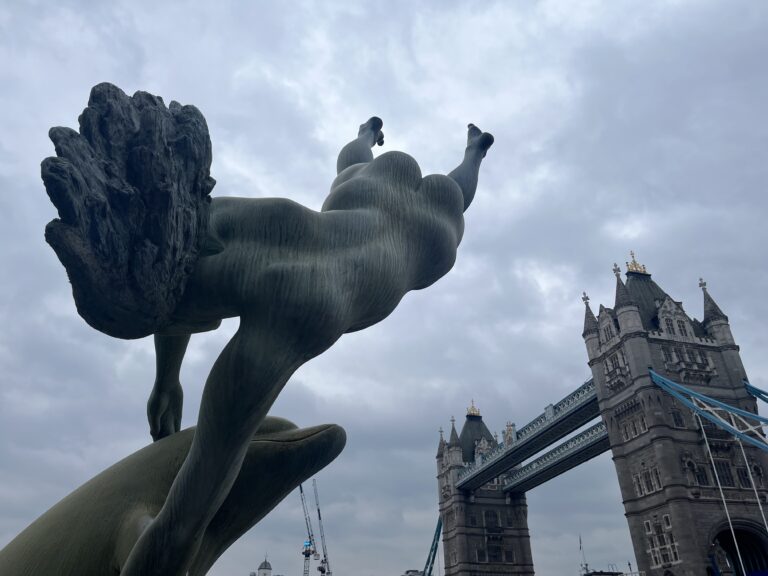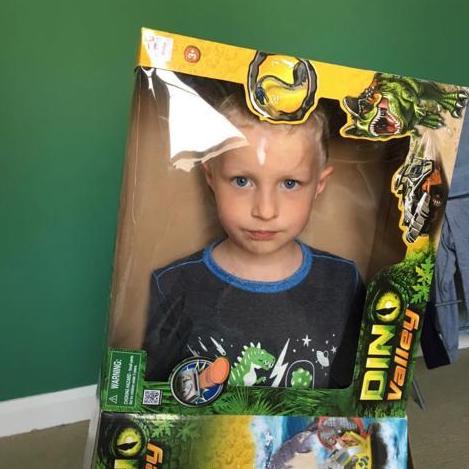Every day, some 20,000 people drive over Tower Bridge in London. What few if any of them realise is that they are passing within a stone’s throw of an ecstatic nude statue of the last British woman to win Wimbledon.
It was exactly 50 years ago today, on 26 November 1973, that Girl with a Dolphin—a 17ft-high fountain featuring a naked woman cavorting with a cetacean—was unveiled on the banks of the Thames. On that occasion, the model’s identity was concealed. Nor was she mentioned in the notice published the following day in The Times beside a photo of the creation. Nor is she named on the nearby plaque, which merely states that the energetic bronze is the work of the British sculptor David Wynne.
This is little wonder, when you reflect that the model, Virginia Wade, was then one of the world’s most famous tennis players. She had won the US and Australian Opens, and would go on to win Wimbledon in 1977. The revelation that she had posed for the curvaceous nude, who dives down to greet a friendly bottlenose, which is arching up to meet her, while an enthusiastic jet of water dissects their embrace, might have proved a distraction from her training schedule.
Yet the suppression of that information, which has remained a secret for half a century, is one among several reasons why this work of art, which is so full of joy and life, hasn’t received the love and attention that it deserves.
Its creator was an untrained sculptor who spent much of his career being sneered at by the art establishment. A rangy man, with a long, handsome face, David Wynne grew up surrounded by horses, since his father ran a livery yard near Lyndhurst in the New Forest. As a pupil at Stowe, he kept a pet owl, like Harry Potter. Then he went up to Trinity College, Cambridge, ostensibly to study zoology. But his tutors soon noticed that he spent more time rowing, going to parties and sculpting his friends. Eventually he received a note from the Master of his college, the historian G.M. Trevelyan. “You will be more use in the world as a sculptor than as a zoologist, therefore you are excused all lectures and will not be required to sit examinations.” This was granted on two conditions: that Wynne rowed for the college and attended the May ball.
The artist developed his craft in the 1950s, when Method actors such as Marlon Brando and James Dean were becoming famous for going the extra mile in pursuit of authenticity as actors. In his art Wynne did likewise, embracing a kind of Method approach to sculpture that involved getting as close as possible to his subjects, no matter the cost. To study a grizzly, he spent three weeks living wild in the Rockies. Once, in Namibia, he was sketching a black rhino when it charged at him. Wynne spun aside at the last moment and escaped with two broken ribs.
When I speak to Wynne’s son, Edward, who is lead singer of the rock band the Ozric Tentacles, he reveals that his father’s fascination with dolphins began at the dolphinarium in Brighton, near where young Edward was at school. “There was a restaurant with a table by the window, where you could watch the dolphins swimming. And he looked at these incredible creatures and started drawing them on his napkin.” Not content with just looking, Wynne later swam regularly with dolphins, both in the wild on foreign holidays and at a London aquarium.
Were humans, then, just another kind of animal, to be learned in the same way? When Wynne was sculpting Queen Elizabeth II, he asked her if he might touch the orbital bone beneath her eye. She remarked that no other sculptor had ever wanted to touch her. “Perhaps they were shy,” he suggested. “Not something one could say of you, Mr Wynne,” Her Majesty replied.
After the artist was introduced to Virginia Wade in the early 1970s, it was natural that, being a keen tennis player himself, he should wish to hit some balls with her. It was his immersive Method approach again: to get to know his subject in her own habitat. Another former British No 1, who also played tennis with Wynne, was Annabel Croft. She tells me that he was as untrained at tennis as he was as an artist. “I’ve always felt the character of a person comes out in how they hit the ball. He was an artistic player, quite flowing, all arms and legs.”
When it came to Wade, Wynne first did a bust of her and sculpted her in action on court. Then he asked if she would be willing to pose for Girl with a Dolphin. “So of course I wasn’t unhappy to do that,” Wade says, when I get her on the phone from New York. Did that mean taking her clothes off, I ask. “Yeah, it did. It was so professional. It didn’t matter at all.” For reasons of discretion, the artist and his model decided not to use her face for the work, but only her body. “We didn’t go around saying it was me. It was just a girl with a dolphin.” A half-century on, however, Wade sees no reason to keep the secret.
What she remembers most about the experience, in any case, was how interesting Wynne was. “You would have fascinating philosophical conversations as it all went on. You’d talk about personal relationships and what was going on in the world.” Wynne had a particular interest in meditation and the spiritual world. Indeed it was he who first introduced his friends, the Beatles, to the Maharishi. Sergeant Pepper, you might say, owes a debt to the Method sculptor from Lyndhurst.
I suggest to Wade that, over the decades, she must occasionally have driven past Girl with a Dolphin with a smile. “Absolutely. I’m very proud of that. Much more proud of it than I ever was of my own personal sculptures, though they’re very nice. The ones of me, they’re just me. But Girl with a Dolphin is just so gorgeous. It gives me a warm feeling that I was involved.”
Everyone I speak to—Wade, Croft, the sculptor and former Chanel model Candida Bond—seems to have been enormously fond of Wynne, who died in 2014 at the age of 88. All are admirers of his work. At her flat in London, Wade has an example: a small statue of a deer. “It’s just awesome. It’s just turning its head a little bit. It’s so lifelike.”
The sculptor Robin Caiger-Smith worked closely with Wynne for many years and is curating a new selection of his work at Stowe, which opens to the public next year. She can see one of his works from where she’s standing, when she talks to me from her home in Cornwall. I ask her about Wynne’s fascination with animals. “He was in awe of their physicality,” she says. “But he was interested in them primarily in terms of the impact they had on him. He thought of man as godlike. In that sense he was of his generation. This was the era of Gerald Durrell, when even the idea of a zoo seemed pretty wild and progressive. Now we think of them as fairly barbaric.”
When you look at another, more famous dolphin sculpture by Wynne, Boy with a Dolphin, which stands near the Thames in Chelsea, you can see her point. In that work, a child, modelled on Wynne’s other son Roly, hitches a ride on a bottlenose, one hand on its dorsal. His face is intent. He’s harnessing the power of the dolphin in order to fly. It’s a handsome work. But there is nothing very surprising about it artistically.
One reason it’s better known than Girl with a Dolphin is that, although it’s badly placed, on the wrong side of the road from the river, it’s in full view of the traffic. Every Londoner has driven past it at one time or another. Most have probably paused at a red light there and sat staring at it for a while. At Tower Bridge, by contrast, the road is 20ft higher than the riverside path where Girl with a Dolphin is situated, which means drivers barely glimpse it. It is appreciated only by the odd pedestrian.
This is a great shame, since Girl with a Dolphin is “gorgeous”, as Wade says. “The woman swims down and the dolphin swims up,” observes Wynne’s son Edward, “and for a fleeting moment they meet within a vortex, and have a mind-to-mind connection, as you do sometimes when you meet a wild animal.” This became his father’s greatest theme. His best works weren’t his busts of the Queen or the Beatles. Nor were they of animals per se. Rather they portray a brief interaction between the wild and civilised worlds—Boy with a Dolphin, for example; Girl with Doves, which stands in Cadogan Square Gardens; and unquestionably, Girl with a Dolphin, which celebrates its 50th birthday today.
So the next time you’re anywhere near Tower Bridge, take twenty minutes to pay it a visit. You can gaze upon the athletic limbs of Britain’s last female Wimbledon winner. But more importantly, you can admire David Wynne’s finest portrait of a human and an animal meeting as equals. The result is an expression of pure joy.

